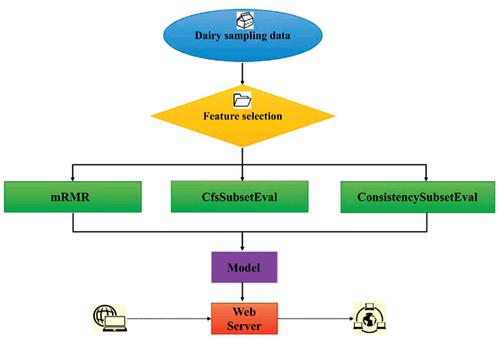Medicinal Chemistry ( IF 1.9 ) Pub Date : 2020-07-31 , DOI: 10.2174/1573406415666191004142810 Jiahui Chen 1 , Guangya Zhou 1 , Jiayang Xie 1 , Minjia Wang 1 , Yanting Ding 1 , Shuxian Chen 2 , Sijing Xia 1 , Xiaojun Deng 3 , Qin Chen 1 , Bing Niu 1

|
Background: Dairy safety has caused widespread concern in society. Unsafe dairy products have threatened people's health and lives. In order to improve the safety of dairy products and effectively prevent the occurrence of dairy insecurity, countries have established different prevention and control measures and safety warnings.
Objective: The purpose of this study is to establish a dairy safety prediction model based on machine learning to determine whether the dairy products are qualified.
Methods: The 34 common items in the dairy sampling inspection were used as features in this study. Feature selection was performed on the data to obtain a better subset of features, and different algorithms were applied to construct the classification model.
Results: The results show that the prediction model constructed by using a subset of features including “total plate”, “water” and “nitrate” is superior. The SN, SP and ACC of the model were 62.50%, 91.67% and 72.22%, respectively. It was found that the accuracy of the model established by the integrated algorithm is higher than that by the non-integrated algorithm.
Conclusion: This study provides a new method for assessing dairy safety. It helps to improve the quality of dairy products, ensure the safety of dairy products, and reduce the risk of dairy safety.
中文翻译:

基于机器学习与化学物质相结合的乳品安全性预测
背景:奶业安全已引起社会广泛关注。不安全的乳制品威胁着人们的健康和生命。为了提高乳制品的安全性并有效防止乳品不安全的发生,各国制定了不同的预防和控制措施以及安全警告。
目的:本研究的目的是建立基于机器学习的乳制品安全性预测模型,以确定乳制品是否合格。
方法:本研究以乳制品抽样检查中的34个常见项目为特征。对数据进行特征选择以获得更好的特征子集,并应用不同的算法构建分类模型。
结果:结果表明,使用包括“总板数”,“水”和“硝酸盐”的特征子集构建的预测模型是优越的。该模型的SN,SP和ACC分别为62.50%,91.67%和72.22%。发现集成算法建立的模型的准确性高于非集成算法。
结论:本研究提供了一种评估乳制品安全性的新方法。它有助于提高乳制品的质量,确保乳制品的安全,并降低乳制品安全的风险。











































 京公网安备 11010802027423号
京公网安备 11010802027423号